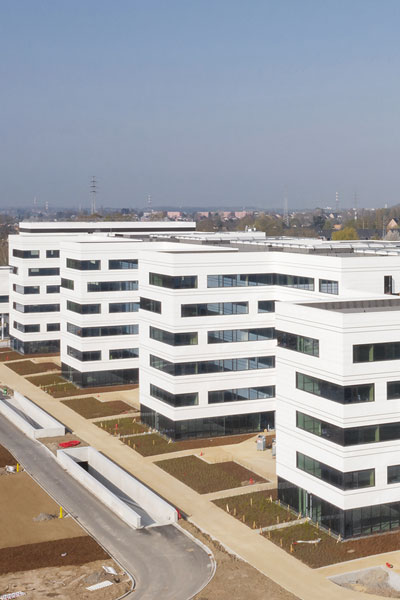
MontLégia, the new clinic in Liège: in the medical world, hygiene is essential.
On the Heights of Liège now stands the MontLégia Clinic which brings together the staff and services and of the three hospitals and clinics of the CHC (Christian Hospital Centre). This facility, with more than 800 beds, was designed by Assar Architects in association with Artau Architectures, and technical design was carried out by Tractebel Engineering. Cegelec and Danneels undertook the installation. Following the specification advice of healthcare architect Alwin Fable, the client, design office and installers opted for Delabie to provide the water controls, stainless steel sanitary ware and grab bars.
The MontLégia Clinic is a figurehead in an area where there is already a nursing home and which will eventually include an enterprise zone; various buildings to house offices, laboratories and clean rooms for biotech companies; CHC's administrative headquarters; an eco-district; and various mixed use projects. The Clinic is located on the site of a former coal mine operated by Patience & Beaujonc. The site, which closed in 1929, was left undeveloped until the management team at CHC decided to consolidate its three Liége-based hospitals, Saint-Joseph, Espérance and Saint-Vincent there.
"Building a new hospital offered the best guarantees for the patient in terms of accessibility and comfort, as well as for the care providers." explained the team at CHC. "The objective was also to consider the main strategy for the next 30 to 40 years and, in particular, to maximise the synergies between the different medical services." And the site has come full circle, since Espérance and Saint-Joseph once served as dispensaries for the workers in the Liége coal industry!
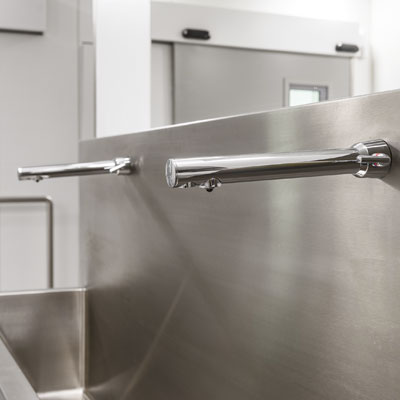
A combination of talents
To deliver this project successfully it was necessary to combine several talents within the design team. At MontLégia, this consisted of an architect (ensuring architectural and aesthetic coherence), healthcare designers (bringing their specialist knowledge to this healthcare building), architectural technicians (bringing their technical expertise to the facades, finishing, etc.) and the project delivery team (who follow the development of the site on a day-to-day basis).
Pierre Maurice Wéry, associate architect at Assar Architects: "Assar's methodology is to tackle each project as a team. A plurality of views which allows the finished building to correspond visually to the initial sketches and conceptually to the project approved by the client. Our work is entirely successful if it is invisible to anyone walking through the building. The challenge is for the complexity to be controlled, for it to appear natural, and for the means of achieving it to be concealed."
Hygiene, an essential element
For Alwin Fable, healthcare architect overseeing the project, hygiene is crucial in a hospital. "As hospital designers, we have a major responsibility to hygiene. The first challenge is to respond to the medical aspect. In addition to this there is patient comfort, compliance with a significant number of regulations and, of course, hygiene. Our contribution is to combine all these elements successfully to create a pleasant living environment, minimising the trauma for the patient, and providing comfort of use for the staff."
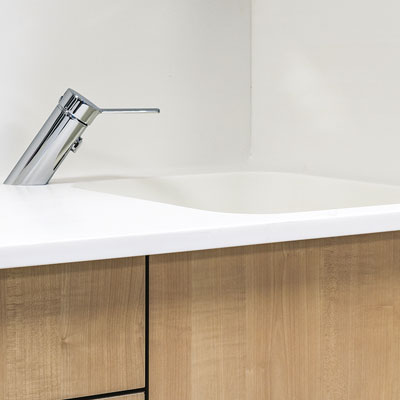
All solutions under one brand
"When we worked with Tractebel on the technical elements" explains Alwin Fable, healthcare architect at Assar Architects, "we tried to offer a global solution across the whole project by thinking of both the end user and the maintenance staff. Our choice quickly fell on Delabie, because this company offers 100% of the solutions that we were looking for. We were able to have an aesthetic solution for the public areas - the rooms and communal areas - and a medical response for the clinical areas. As a healthcare architect, it is very important for me to have water controls that are fit-for-purpose, and the client was of the same opinion. Delabie is well-known for the quality of its mixers and taps. The characteristic smooth bodies of the brand help to actively fight against bacteria."
Thomas Bottemanne, Business Development Manager at Delabie, confirms: "Hygiene is an essential aspect in the hospital environment. With our various products, we were able to meet the initial challenges posed by the client: have water controls that fight against the bacteria that can develop in the network and also at the point-of-use itself."
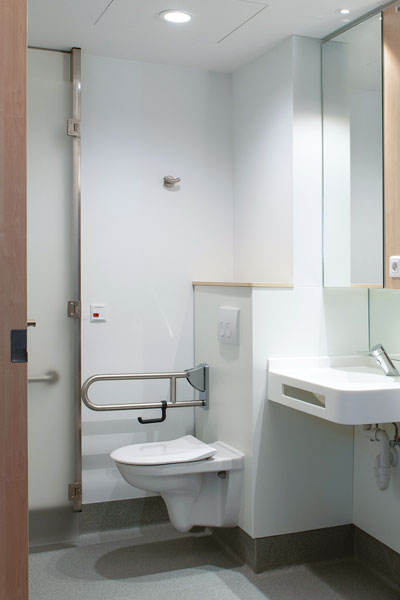
A certain experience
Delabie is used to working with healthcare facilities and part of its website is devoted to this specific area. In Belgium, Delabie's mixers and taps can be found in CHIREC - Hospital Delta (Auderghem), in HWAPI (Tournai), in the extension at the Namur Regional Hospital and at the new Jules Bordet hospital (Brussels). At MontLégia, in addition to grab bars, drop-down rails and shower mixers, DELABIE supplied large quantities of three types of mixers and taps, guaranteed for 10 years: BIOSAFE basin mixers for the rooms, TEMPOSOFT time flow push-button taps for public washrooms and TEMPOMATIC 4 MIX and BINOPTIC MIX electronic mixers for the clinical stainless steel scrub-up troughs, notably located between the operating theatres.
Alwin Fable explained this choice: "We specified push-button time flow taps in the public washrooms to avoid managing batteries or infrared systems. In the clinical areas, on the other hand, we opted for infrared versions with more extensive monitoring and controls."
In the rooms
BIOSAFE basin mixers, which have a body with a smooth interior, are distinguished by their lack of spout. Thomas Bottemanne explains: "The reason is very simple: the spout is a part of the mixer where there is an increased risk of bacterial development. At the end of the spout there is air and water, all that's needed to allow bacteria - Legionella spp and Pseudomonas aeruginosa - to develop. Here the hot and cold water are delivered directly to the cartridge and, therefore, the mixing mechanism, which makes it possible to to reduce the water volume inside it to a strict minimum when the mixer is closed.
This is another advantage in the fight against the appearance and development of bacteria that convinced the architects, the client and the design office."
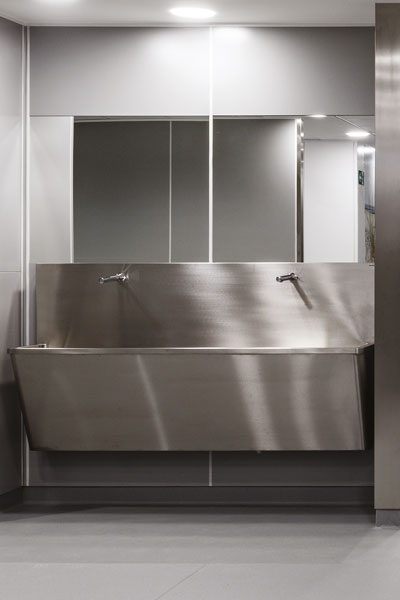
For healthcare professionals
Stainless steel scrub-up troughs in clinical areas - near operating theatres, for example - are fitted with BINOPTIC MIX electronic mixers, another flagship range offered by Delabie. "We chose this electronic mixer because the sensor is located at the end of the spout and not on the wall" says Alwin Fable.
"In addition to the water savings it delivers (90%), this model also offers another valuable advantage." explains Thomas Bottemanne: "The body has a smooth interior and a piston-operated solenoid valve, developed in-house. This solenoid valve renews the water inside the mixer with every use. Other manufacturers use solenoids with a membrane which have a major disadvantage: there is always an area where water stagnates and is never replaced, allowing bacteria such as Legionella or Pseudomonas to develop."
Two studies - one carried out by the University Hospital of Antwerp and the other by the Jules Verne University in Amiens - have recently shown that, if the electronic mixers are not equipped with the right equipment, they provide an enhanced vector for bacterial development. "However, if you are choosing an electronic mixer, it is to save water, but also for hygiene reasons" continues Thomas Bottemanne... "the models installed at MontLégia also feature an automatic duty flush. If the mixer is not used for 24 hours, it automatically activates for one minute, drawing water through the system and preventing any bacteria that might be present in the water from developing."
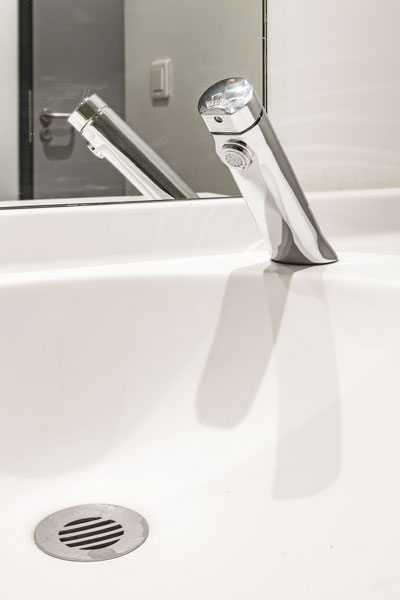
A fruitful collaboration
The client, architects and installers are completely satisfied with their collaboration with Delabie. "Our role is to enter into the details of the technical explanation of the product." admits Thomas Bottemanne, who concludes "A mixer may seem like an insignificant item in a hospital building of this size. However, it can be a cause for concern if there is bacterial development and germs start to spread. It must, therefore, be given special attention."
According to Pierre Maurice Wéry "Delabie has a strong presence on the market, and the representatives not only have a commercial role, but they also have a technical understanding of the product offered. This ability to communicate and be understood by other professionals in the construction process is essential nowadays." The compliment is all the more valuable coming from an architect whose office has designed well-know healthcare facilities (CHIREC- Hospital Delta, Maria Middelares in Ghent) and is currently designing several others (Assar recently won the project for the St Pierre Clinic in Wavre). Assar is also working on international projects (Luxembourg and Paris). Their credentials are well established, attracting more and more clients, elevating their international status, and resulting in the opening of a branch in the very heart of Paris.
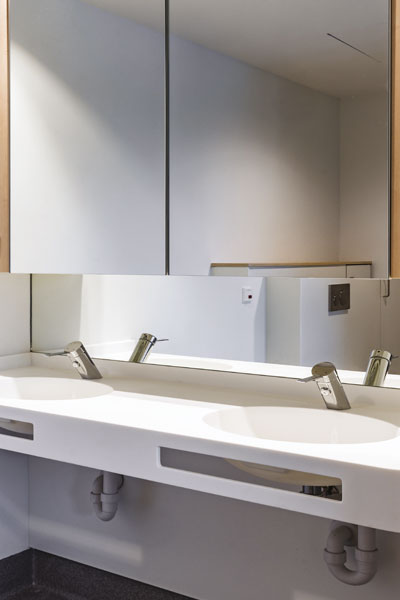
DELABIE products installed
Sink mixer with swivelling spout and long lever - reference 2210LBEL
Sink mixer with swivelling spout and retracting hand spray - reference 2211
Shower mixer - reference 2239
Wall-mounted sink mixer with swivelling spout - reference 2519L
BIOSAFE basin mixer - reference 2621MINIBEL
TEMPOSOFT 2 time flow basin tap - reference 740500
BINOPTIC MIX electronic basin mixer - reference 379MCH
TEMPOMIX time flow shower mixer - reference 790310
Stainless steel drop-down rail L. 650mm, satin finish - reference 510160S
Stainless steel toilet brush, polished satin finish - reference 4048S
Stainless steel toilet roll holder, satin finish - reference 4081S
Stainless steel double coat hook polished satin finish - reference 4042S
Surgical scrub-up trough with high upstand - Hygiene+ design - reference 186100
Photo credits: Marc Detiffe


